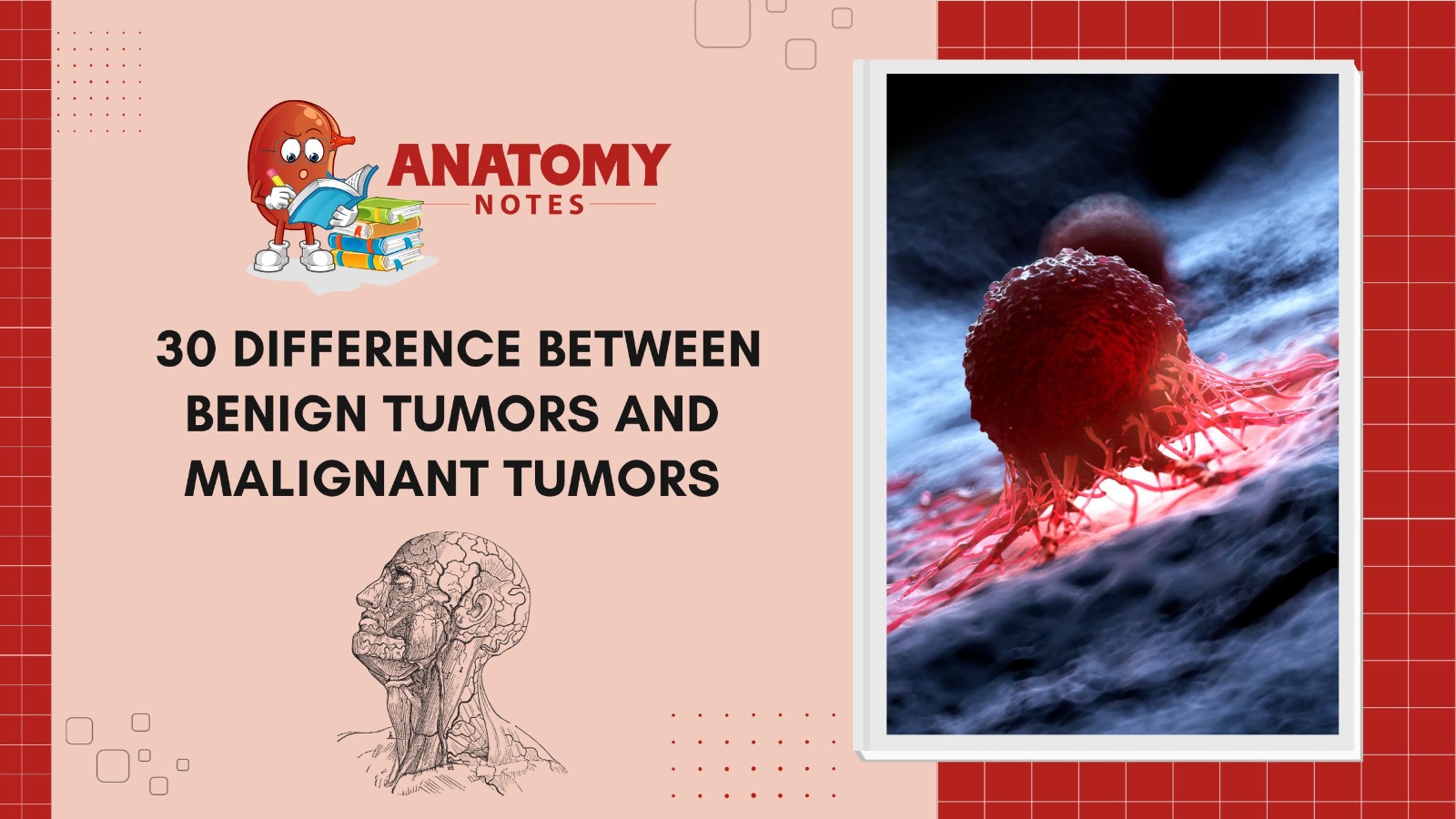Tumors are often classified as benign or malignant based on their health risks. These differences are critical to medical diagnosis and therapy. The development patterns, invasiveness, spreadability, and health effects of benign and malignant tumors differ. Benign tumors develop slowly and locally. They usually stay localized and don’t infiltrate surrounding tissues. Their cells have a clear structure and resemble regular cells. These tumors seldom expand or infiltrate essential organs, therefore they rarely threaten health. Benign tumors removed surgically are frequently curable and seldom return.
However, malignant tumors are more aggressive. They swiftly infiltrate neighboring tissues and organs, compromising their function. Under the microscope, malignant tumor cells may vary in size and form. Cancer is characterized by uncontrolled proliferation. Malignant tumors can metastasize through the circulation or lymphatic system, unlike benign tumors. This metastatic ability determines disease severity and prognosis.
Another major difference between benign and malignant tumors is the health effect. Although not always harmless, benign tumors frequently create symptoms by pushing against surrounding tissues. If they hurt or inhibit body functioning, they should be removed. However, invasive malignant tumors can disrupt key processes and cause major health issues. Chemotherapy, radiation therapy, targeted medicines, and surgery are used to treat malignant tumors and prevent metastasis.
Therefore, benign and malignant tumors differ in behavior, growth patterns, and health effects. Malignant tumors are fast-growing, invasive, and can spread, while benign tumors are slow-growing, confined, and less aggressive. Correct identification and distinction between these two tumor types are crucial for medical management and therapy.
Also Read: 32 Differences between Eczema and Psoriasis
Here are 30 differences between benign tumors and malignant tumors conditions:
|
S.No. |
Aspect |
Benign Tumors |
Malignant Tumors |
|
1 |
Cell Growth |
Slow, controlled growth of cells. |
Rapid, uncontrolled growth of cells. |
|
2 |
Invasion |
Does not invade nearby tissues. |
Invades nearby tissues and can spread to distant sites. |
|
3 |
Metastasis |
Does not metastasize (spread to other parts of the body). |
Metastasizes to other organs or lymph nodes. |
|
4 |
Tumor Border |
Well-defined, encapsulated tumor borders. |
Irregular and poorly defined tumor borders. |
|
5 |
Cell Differentiation |
Cells look similar to normal tissue cells. |
Cells may show abnormal differentiation and may vary. |
|
6 |
Growth Rate |
Generally slow growth rate. |
Can have a rapid growth rate. |
|
7 |
Recurrence |
Rarely recurs after surgical removal. |
Can recur after treatment or surgical removal. |
|
8 |
Overall Prognosis |
Generally a favorable prognosis. |
Generally a less favorable prognosis. |
|
9 |
Cell Adhesion |
Tumor cells adhere tightly to each other. |
Malignant Tumor cells often have poor adhesion. |
|
10 |
Risk of Systemic Effects |
Rarely causes systemic symptoms. |
Can cause systemic symptoms, such as weight loss. |
|
11 |
Treatment |
Usually requires less aggressive treatment. |
Often requires more aggressive treatments like chemotherapy. |
|
12 |
Normal Cell Interaction |
Tends to maintain some normal cell interactions. |
Disrupts normal cell interactions and tissues. |
|
13 |
Genetic Mutations |
Fewer genetic mutations in benign tumors. |
More genetic mutations and instability in malignant tumors. |
|
14 |
Cell Atypia |
Less cellular atypia (abnormal appearance). |
Cellular atypia (abnormal appearance) is common. |
|
15 |
Risk of Death |
Rarely leads to death unless affecting critical structures. |
Can be life-threatening and lead to death. |
|
16 |
Growth Symmetry |
Benign Tumor growth is usually symmetrical. |
Growth is often irregular and asymmetrical. |
|
17 |
Local Destructiveness |
Typically less locally destructive. |
Can be locally destructive and invade nearby structures. |
|
18 |
Tissue Necrosis |
Rarely causes tissue necrosis (cell death). |
Can cause tissue necrosis due to inadequate blood supply. |
|
19 |
Angiogenesis |
May have limited angiogenesis (formation of blood vessels). |
Often induces angiogenesis to support rapid growth. |
|
20 |
Response to Treatment |
More responsive to treatment. |
May be less responsive to treatment, especially in advanced stages. |
|
21 |
Cytology |
Cytology shows normal or mildly abnormal cells. |
Cytology shows highly abnormal and irregular cells. |
|
22 |
Impact on Organ Function |
May compress nearby organs but often retains function. |
Can disrupt and impair the function of adjacent organs. |
|
23 |
Risk of Complications |
Less likely to cause complications. |
More likely to cause complications. |
|
24 |
Diagnostic Imaging |
Typically well-defined on imaging studies. |
Often presents as irregular or infiltrative on imaging. |
|
25 |
Immune Response |
May trigger a mild immune response. |
May evade or suppress the immune response. |
|
26 |
Cellular Structure |
Cells resemble normal tissue cells. |
Cells show abnormal and disorganized structures. |
|
27 |
Hormone Production |
Rarely produces hormones. |
Can produce hormones (paraneoplastic syndromes). |
|
28 |
Risk of Spread |
Rarely spreads beyond the primary site. |
High risk of local and distant spread. |
|
29 |
Diagnosis |
Often diagnosed incidentally or through routine check-ups. |
Often diagnosed when symptoms or complications arise. |
|
30 |
Examples |
Examples include benign moles, fibroids, and lipomas. |
Examples include malignant tumors like lung cancer, melanoma, and leukemia. |
Also Read: What is the respiratory system? What are its organs and functions?
Frequently Asked Questions (FAQS)
Q.1 What is the main difference between benign and malignant tumors?
The main difference is their conduct and damage potential. Localized benign tumors develop slowly and do not infiltrate neighboring tissues. Usually not life-threatening. Due to their invasiveness and metastasis, malignant tumors grow quickly, infect adjacent tissues, and can be fatal.
Q.2 Can benign tumors become cancerous?
Benign tumors can undergo “malignant transformation.” This is uncommon and depends on the tumor kind. To detect tumor behavior changes, regular medical assessment and surveillance are necessary.
Q.3 How are benign and malignant tumors diagnosed?
Imaging (X-rays, MRI, CT scans), biopsy (tissue sample for study), and other specialist tests are used to diagnose. Pathologists analyze tumors under a microscope to assess cell type, structure, and growth pattern to distinguish benign from malignant tumors.
Q.4 Are all malignant tumors cancer?
All malignant tumors are cancer. Cancer is characterized by its invasive and potentially metastatic characteristics, which makes it “malignant”. Malignant tumors spread and cause cancer in several bodily areas.
Q.5 What benign and malignant tumor treatments are available?
Tumor kind, location, and patient characteristics determine treatment. Surgery can remove benign tumors that cause symptoms or hinder function. Surgery, chemotherapy, radiation, targeted treatment, and immunotherapy are used to treat malignant tumors. The objective is to eliminate or control the tumor, prevent its spread, and enhance the patient’s quality of life.




